The tour started pleasantly, under a blue-overcast morning sky.
To our right, the Santa Cruz Boardwalk formed a stoic background in its wakefulness.
A slight urban hum was overpowered at times by nowhere-near-ferocious waves folding onto the city’s most popular tourist beach.
On this Wednesday—April 30—it was empty. But as we were about to learn, though July 4th crowds were but a memory, there were still globally significant ecological and geological processes at play, beneath the surface.
“I want to introduce the watershed to you,” said hi-viz-vested Chris Berry, who, as watershed compliance manager for the City of Santa Cruz, was probably the right person to make the introduction between the San Lorenzo River mouth and the group of water quality professionals from around the state. “You’ve got listed species in the lagoon.”
Renowned coastal geomorphologist David Revell, of Integral Consulting, stood to Berry’s right, in a black Patagonia puffer over a turquoise shirt featuring a sea turtle with an ocean sunset body.
“We’re lowering the water, but not letting all of the lagoon habitat out,” he said, referring to the complex dance city engineers—with the blessing of local voters—are doing to mitigate the impact of steps taken in the 1960s to sculpt the beachfront to mid-century tastes. “It really does take a village.”
It was Day 2 of the four-day Salmonid Restoration Federation Conference, the premier gathering concerned with salvaging and promoting salmon habitat in California, if not the United States.
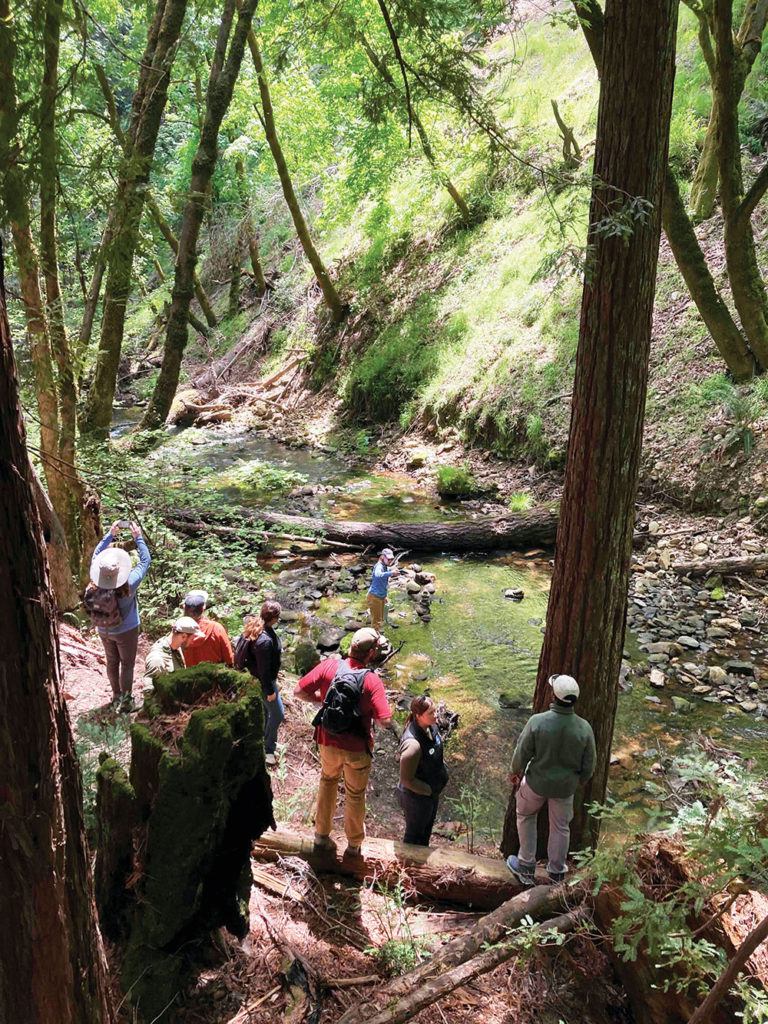
Today, the environmental officials were heading out into the field on a series of explorations of the Santa Cruz County landscape, before heading back for a couple academic days of workshops and presentations.
I was at the conference by chance: I’d randomly grabbed a newsletter from a local nonprofit that had an article about steelhead counts on the front. I casually mentioned my reading material in passing to Coastal Watershed Council Executive Director Laurie Egan, on my way into the Good Times office we share.
She brought up the salmon summit and said she might still be able to get me in.
Days later, over in Los Gatos with my Los Gatan editor hat on, covering their annual Town-sponsored environmentally focused Spring into Green event, I met Joshua Lopez, of the South Bay Clean Creeks Coalition.
Even though it was a completely different watershed—divided by the Santa Cruz Mountains ridgeline—I suggested he might be interested in the salmonid conference that was about to kick off.
Lopez told me he was already planning to attend—he was looking forward to harvesting important knowledge that could help with a fish ladder project they’re working on for Los Gatos Creek.
We’d loaded up into vans at the Resource Center for Nonviolence on Ocean Street.
I was joined by Rachel Couch, of the Oakland-based State Coastal Conservancy, and Don Allan, a volunteer board member with Baduwa’t Watershed Council.
Allan recounted the history of how the waterway his group looks after in Humboldt County was named the “Mad River” because of a crazy-seeming altercation between explorers back in the 1800s.
They used to be the “Mad River Alliance,” but their organization was renamed, in consultation with the Wiyot Tribe, two years ago.
“We consulted with the Wiyot Tribe,” he said. “We had their blessing to do it.”
“I can’t wait to learn about the San Lorenzo River,” said Couch, as the van pulled up to East Cliff Drive and parked at Seabright Beach.
The San Lorenzo River occupies a key space in the local psyche—for example, it’s part of the mural at the Wild Roots grocery store in Felton and is the central feature of the Press Banner T-shirt I wore that day.
In the 1923 silent film Soul of the Beast, an elephant squirts villain Caesar Durand, played by Noah Beery, with water from the river, at Junction Park in Boulder Creek.
In 1851, “TRAI-PAX-E, chief,” “HABITO” and “CO-TOS” were among the members of the “Si-yan-te” tribe to walk all the way from their home in the mountains here to Camp Fremont, near the Little Mariposa River, to sign “Treaty M” with the United States government.
The treaty was never ratified.
Today, the City of Santa Cruz has ongoing restoration work along Zayante Creek (named for these Awaswas-speaking people)—which flows into the San Lorenzo.
It now works with the Amah Mutsun Tribal Band, which represents the descendants of native Ohlone people who attended missions San Juan Bautista (Mutsun) and Santa Cruz (Awaswas).
In The Ohlone Way: Indian Life in the San Francisco-Monterey Bay Area, Malcolm Margolin notes that traveling Europeans were often given gifts of salmon, sturgeon and mussels by the residents.
“From so much water the Ohlones gathered an immense harvest of fish and waterfowl,” he writes in his ALMOST AMPHIBIOUS chapter. “The Ohlones fished constantly using seine nets, dip nets, harpoons, weirs, basketry traps, hooks, and fish poisons.”
A 2022 State Office of Environmental Health Hazard Assessment report prepared by Mike Grone, of the Amah Mutsun Land Trust, noted climate change is now putting additional “physical, cultural, and spiritual” pressure on the Indigenous people—and on salmonids.
“Rising temperatures and drought have decreased water flows and led to warmer waters in culturally important fish habitat and unfavorable spawning conditions,” it reads. “Salmon populations are impacted by nutrient availability, drought, temperature, and freshwater/saltwater interfaces, all of which are affected by climate change.”
The tribe has been working with Michigan State University researchers to study ancient and modern salmon and steelhead genetics, and has a DNA monitoring program for species of ecological and cultural importance with UCLA.
In Superman’s Not Coming: Our National Water Crisis and What WE THE PEOPLE Can Do About It,” Erin Brockovich looked at environmental rollbacks under the first Donald Trump Administration, as he postured with coal miners in front of the Environmental Protection Agency headquarters.
“Why do we have to choose between environmental protections and economic development?” she asks.
She points to research from economist W. Reed Walker that found the 1990 Clean Air Act amendments found the average worker who lost their job due to the increased regulations had an average earnings drop of about 20 percent and caused total wage losses of $5.4 billion; the EPA said the overall health benefits amounted to $5.4 trillion.
In an Oct. 25 appearance on the Joe Rogan Experience, Donald Trump said environmental tools and regulations are the biggest impediment to the growth he’d like to see to help eliminate the national debt.
“If you looked at it purely as an asset value, we have oil underground, we have water, we have mountains—I mean, the assets are so enormous,” he said, looking back on his career as a developer. “Of all of it, to me the toughest thing was the environmental. Because they could stop you cold with the environmental impact study stuff…it’s a morass—it’s horrible.”
“Right, but there are legitimate concerns about environmental impact, correct?” Rogan pushed back, bringing up the BP oil spill. “There’s a lot of things that do happen that are environmentally devastating, and you want to mitigate that as much as possible.”
“Sure,” Trump said, quickly switching to brag mode. “During our four years we had the cleanest air and the cleanest water.”
He didn’t point to any particular statistic to back up these claims.
Health and Human Services Secretary Robert F. Kennedy Jr. gets praise for his environmental legacy, particularly in forcing polluters to clean up New York’s Hudson River.
But Trump told the top podcaster not to expect Kennedy to expand that watershed activism nationwide.
“The only thing I want to be a little careful about with him is the environmental, because, you know, he doesn’t like oil—I love oil and gas,” he said, with a smile. “I said, ‘focus on health.’”
Meanwhile Brockovich has been gathering participants for a class-action lawsuit following the fire at the Moss Landing energy-storage plant that spewed heavy metals from giant batteries into the air for two days earlier this year, from its perch at the edge of the Monterey Bay.
Afterwards, marine researchers reported elevated levels of nickel, cobalt and manganese in the Elkhorn Slough.
Though smoky conditions blanketed the Santa Cruz Mountains on the second night, authorities were divided on whether any of that could’ve drifted all the way up to the San Lorenzo Valley, given the eastward direction of the main plume.
For the second stop, the tour group arrived at the levee next to Good Times, where Coastal Watershed Council river ecologist Kaiya Giuliano-Monroy explained she drew inspiration from her work with the Amah Mutsun Land Trust for a seeding initiative here.
“I saw it could work,” she said.
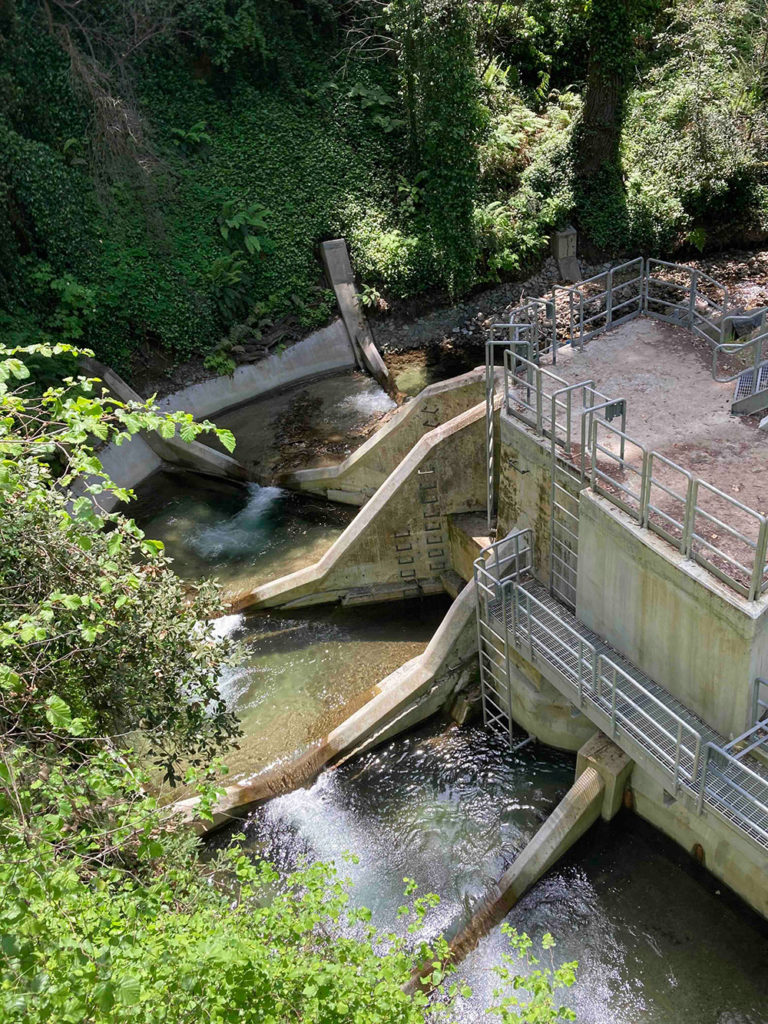
The riverbanks that had once been largely barren, due to rampant homeless encampments, now billowed with bushes and scattered wildflowers.
“They have worked hard,” she said of the 27 unhoused volunteers who joined in the effort, many of whom “got poked with a lot of Himalayan blackberries.”
We walked upriver, toward the pedestrian bridge to downtown, and gazed at what used to be a tent city, full of old bicycle parts, strewn garbage and drug deals going down right in the open.
Here at the San Lorenzo Riverlands (a park for more than a century, formerly known as the Benchlands), the grass on what once was dirt is so thick it has to be mown by a large machine.
Jeremy Leonard, a City outreach worker, said they do a pass along the levees once or twice a day and try to offer support services to the homeless.
“We see a lot of impacts on our watershed,” he said. “It’s a highly politicized topic we work within.”
That’s only been exacerbated by the recent—and looming—federal funding cuts.
For example, they have a $2.8 million grant from NOAA to reimagine the Riverlands (in partnership with the Amah Mutsun), from an outdoor event space to something more natural.
City officials have been getting word that money’s safe, for now, but say other dollars could be on the chopping block.
Next up, we popped a few blocks over to the Branciforte flood control channel.
Justin Gregg, principal hydrologist for Environmental Science Associates, said they’re trying to modify the man-made water-routing structure to encourage coho salmon to swim further upstream.
“You want to roughen the channel and provide resting pockets for fish,” he said.
Scientists say they have to learn more about salmon habits if they want the region to remain vibrant.
“We know so much, and so little at the same time,” said William Ware, project coordinator with the nonprofit California Trout.
One thing’s for sure, he said, what happens on the agricultural and residential land upstream can impact the journeys of the salmon down here.
The tour learned that this aspect of San Lorenzo River conservation has been imperiled by Trump Administration cuts.
We headed up to Boulder Creek a little before noon.
Just down the bend from Junction Park, where an elephant had its celluloid moment, you’ll find a partially dismantled dam that dates to the same era.
There you’ll find a watering hole with people going for a swim, playing fetch with their dog alongside their daughter, or sitting on the concrete that juts into the river.
Recreation officials say the manmade waterfall and defunct fish ladder is too much of a barrier for salmon.
But there’s been pushback from community members who aren’t exactly eager for change. Some say the needs of salmon—and river health—should win out. Others don’t want to lose a key recreation asset, or would prefer a homegrown solution, instead of one imposed by County officials and consultants.
Matt Weld, a civil engineer with Waterways Consulting who grew up nearby, said they’ll have to consider a range of factors to solve the puzzle.
“The easy barriers are already dealt with,” he said. “This is a remodel.”
There are currently 37 structures along the San Lorenzo River, including 18 “high,” six “medium” and three “low” barriers to salmon passage, a Resource Conservation District of Santa Cruz County official told us.
We cruised back down the hill, past the landfill in Ben Lomond to Newell Creek, arriving at the historic Nelson House, where the City of Santa Cruz hosts outings for students.
Newell Creek is the pathway for water from Loch Lomond—Santa Cruz’s only drinking water reservoir—to the San Lorenzo River.
Here Chris Hammersmark, a director and ecohydrologist at CBEC Eco Engineering, showed off a “large woody debris mitigation” project they’d worked on.
“The guidance was to improve 500 feet of stream,” he said. “It was really more like, let’s get some more wood in the stream.”
The constraints included anticipating intense rainfall and periodic landslides. The benefits? Not having to go to the hardware store for lumber.
“There was a lot of material available,” Hammersmark said.
So, they “chopped and dropped,” assembling 20 or so trunks and branches into helpful patterns.
We were able to see how they’d engineered more pooling areas, creating chill places for fish—and the bugs they like to eat.
City officials say the costly improvements will be quite the nice amenity for the resident trout. And they’re hoping to start seeing fish from the ocean here soon.
Then, it was on to another salmon ladder—this time just outside of Felton at Fall Creek, a half mile from where it enters the San Lorenzo.
A $1.1 million California Department of Fish and Wildlife grant paved the way for the most recent construction.
Officials drew on efforts to help lamprey and salmon up the mighty Columbia River.
It’s important to do the job right, we learned, as an earlier retrofit at this San Lorenzo Valley Water District intake point actually caused some issues—such as sub-concrete seepage.
And the edges of the structure were so sharp that lamprey had trouble using their suction abilities.
A negotiation played out with State and federal regulators, and project officials were able to move forward with a one-foot jump height requirement, instead of the six inches they were initially supposed to use to accommodate juveniles.
Next, we headed up to Frenridge Road to see the results of an Environmental Protection Agency “319” grant. (“We probably won’t see too much of that in the future,” mused Berry.)
The group hiked for a few minutes through gentle understory, beneath the towering second-growth redwoods, and came upon Zayante Creek.
Here logs seemingly tumbled into the bend at multiple points. Water bugs zipped this way and that. And—if you knew where to look—you could see baby steelhead in quiet, yellow-green water pockets.
These tiny creatures would dart quickly in one direction, then hover as if frozen in time.
Lisa Lurie, executive director of the Resource Conservation District, said the habitat in this particular reach had been simplified and pools weren’t forming.
They wanted to make sure there was enough sediment.
But now, the logs we climbed and rested against had been locked into place with a metal pin. Others were affixed to a large tree.
Project officials said they were thankful the landowners had been so supportive.
“It’s really important that you’re keeping everyone moving together,” Lurie said, emphasizing the value of a coherent public communication strategy.
One of our guides shared that they have multiple clients now trying to “put wood into systems” that previously paid to have this type of material ripped out.
Betsy Stapleton, a project development and permit specialist with the Scott River Watershed Council, based up in Siskiyou County, said she was finding the tour quite beneficial.
“It’s very easy to get insular and just think about your own issues,” she said, adding it was a joy to connect with her peers.
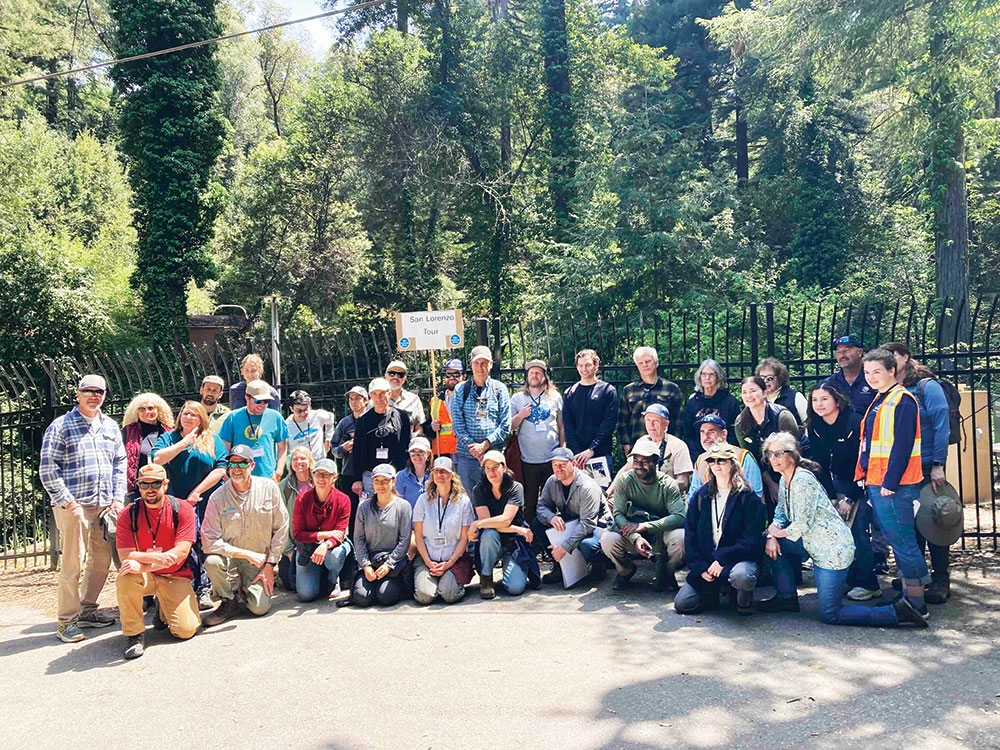
Invasive species alert
Our van got lost on the way to the edge of Henry Cowell Redwoods State Park.
Once our contingent caught up to the tour, a Santa Cruz County official was exhibiting a wild river section where the pond turtle—a listed species—lives.
We learned that we were standing at “ground zero” for a new invasive “shothole borer” (Euwallacea interjects—originally from Southeast Asia).
The California Department of Food and Agriculture’s Pest Detection Labs describes it as a “shothole borer beetle-pathogen complex.”
It’s still unclear how far the infestation—that affects box elders, California sycamores, coast live oak, arroyo willow, red willow and black cottonwood—has spread.
Lopez, the guy I’d met at Spring into Green in Los Gatos, was drinking it all in.
“It’s like an information dump,” he said. “I got to learn the other side of the mountain—and the challenges these river systems are going through.”
At every stop, a different approach to improving stream health had been deployed, he remarked.
“In our project, the City of Campbell didn’t want to remove the drop structure…The solution to that is to put in a series of boulders that raise the riverbed up,” he said, giving the tour a positive review. “I really enjoyed this and would do it again.”
We dropped down to the base of the mountain, stopping just before Santa Cruz periphery—another former tent city.
Now those campsites were nowhere to be seen, the discarded syringes in the parking lot the only immediate reminder of that recent era.
Down the Sycamore Grove trail, by the graffitied-concrete ruins of an old smokestack, Ryan Wall, chief ranger with the City, commented on the ecological progress.
“It’s been quite successful,” he said of their efforts to dismantle homeless settlements, noting they’d just finished cleaning up a section along Redwood Creek.
Decades ago, this had been home to an actual sanctioned campground, Berry noted.
“San Lorenzo was a huge fishery back in the day,” Berry said.
We also got a lesson in what happens when the City accidentally pollutes the river.
The City had been directionally drilling and ended up spilling fracking material—in this case, bentonite (clay)—into the river, contaminating .3 acres.
To compensate, the City removed trash from this portion of Pogonip, completed a half-acre project along East Zayante Road and conducted a .2-acre habitat restoration in another location.
The projects were hit-or-miss in terms of effectiveness, in part because unhoused individuals kept ripping out plantings, according to the City, but ultimately CDFW decided they’d “overmitigated,” and gave them the thumbs-up.
Max Ramos, a restoration engineer who works for the Yurok Tribe, said the educational outing covered familiar territory, since he grew up in Santa Cruz.
However, he said it was helpful to learn the particulars of what’s going on environmentally in his hometown, as he moves forward with a blockbuster remediation up north.
The experts in my van told me he’s involved in “the most significant” river health project in California.
Last year, the Yurok removed four dams along the Klamath River. Chinook salmon were spotted upstream pretty much right away.
“It’s been the quickest response to large scale dam removal in the Lower 48,” Ramos said. “It’s been awesome.”





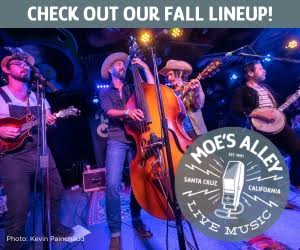

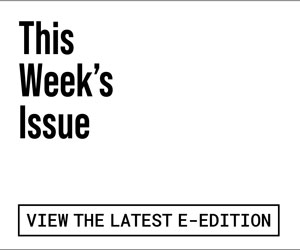






Great article, thanks. You pulled together a lot of disparate and detailed info into a fun read.